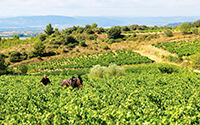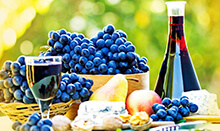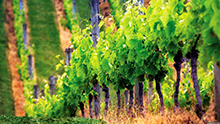Bio-dynamic Wine – Wine of the Future

Bio (bios), meaning life and Dynamis (dynamis), meaning motion and strength in the Greek language. This is what lies at the heart of this unique term that has the conspicuous meaning of «life force» (The force of life).
The term «biodynamics» was first proposed by the Austrian philosopher-mystic and founder of anthroposophy, Rudolf Steiner, in 1924. The philosophy of «biodynamic» is how to improve the quality and quantity of a harvest by using the forces of nature. Despite the fact that Steiner’s ideas spread to all types of agriculture, their real popularity was realised in the environment of winemakers in the 1970s. A driving force behind biodynamics in wine has been the French specialist in wines, Nicolas Joly. On his business cards, he always includes the message: «Help nature, not the winemaker.»
Biodynamics in viticulture and winemaking
Biodynamics — is, first and foremost, a philosophy that features a belief that the earth is a living organism. According to this philosophy, the winemaker is living in harmony with nature and the cosmos. Soil, plants, insects, animals, sun, water, moon and the stars — all equally affect the maturation of the grapes and, subsequently, the quality of the wine.
During the construction of biodynamic wineries, respected classical architectural laws are adhered to that take into account the angle of sunlight. All the work in the vineyard or in the cellars is carried out based solely on the lunar calendar (and some work is even done at night to collect moonlight in empty plastic bottles).
By the principle of biodynamic, vineyards should organically fit into the natural environment; to be a part of it. The vineyards often look overgrown by various weeds or as a vegetable garden, but (in fact) these are not considered weeds, but a variety of herbs that have grown for hundreds of years on the land that is occupied by grapes. Sometimes, other plants are planted, like lupine, white clover, alfalfa, mustard or even roses. All these plants are very important for grapes because they reduce the population of bacteria and fungi that contribute to the interruption of the various diseases of grapes and they develop biodiversity, which heals the soil.
For fertilizer, only compost can be used, which is produced in the same household. It includes added special preparations of quartz, oak bark, chamomile flowers and yarrow, nettle, and valerian. The winemakers fill a cow horn with it (fertilizer # 500) and then it is buried until spring. During a term of six months, the impact of cosmic forces becomes a «spiritualized» influence and if it is diluted properly with water and the spray the land, the vineyards will give excellent yields. This composition is also used for the treatment and prevention of diseases of the grapevines.
The vineyard is always processed manually or with the help of animals (horses and cows) and the mechanical effect is minimised.
Some enthusiasts will talk with the vines and the most advanced methods of «bio-dynamistry» give each barrel special names, such as «Energy» or «Life». The proponents will include classical music in the cellars during the aging of the wine. When fermented, the mash is stirred for half-an-hour in a clockwise direction and half-an-hour in an anti-clockwise direction, thus keeping balance and harmony. The fermentation of wine is achieved through only natural yeast from a local origin. Maturation takes place for these «only organic» wines in new oak barrels, fired from inside to limit the influence of the texture of oak tannins and tannic quality on the future wine. Wine is poured from barrels into bottles only during a «waxing moon».
The properties of bio-wine
It is believed that once opened, bio-wines keep their aromatic and flavour characteristics much longer than other wines. Prices for biodynamic wines are higher than the usual wines by about 20%. This is reasonable, since the manual labour used in the creation of biodynamic wines is much more intense. Hervé Jestin from Champagne, who owes much to «Abrau-Durso» in Russia, has guided the miraculous transformation of production of full champagne brands of sparkling wine. He is the winemaker/biodynamist. The workers of the plant, where he makes short visits on occasion, are afraid of him, especially after seeing him (one night in Abrau) gathering moonlight into the empty plastic bottles, which he then placed under the wine barrels. The wines, which are made by Hervé in Champagne, periodically receive the highest ratings from Bettane & Desseauve, the most progressive wine guide in France. Biodynamic wine in the glass really does look different. It is always more vivid and clean, with intense smells, although sometimes they can be pretty strange. They claim to be wild, rough and energetic and they are, overall, brighter and more intense than conventional wines.


Biodynamics and organics
Wines, claiming the status of organic or biodynamic, are produced in small wineries using manual labour. In fact, there is little difference between organic and biodynamic wines. The meaning of organic signifies everything from the ground at a maximum, without doing violence with non-degradable or poorly degradable inorganic fertilizers. Organics is not such a radical method, compared to biodynamics. Organics does not concern itself with lunar cycles and is less intimate with the chemical samples of the earth. The wine grapes are far different than those born of biodynamics, where grapes are tenderly collected by hand and nature is allowed to feed the soil naturally and beautifully. It focuses on the chemical purity of the land and the grapes. All fertilizers, of course, are natural.
Many professionals believe that the taste of biodynamic wines is brighter, with an aroma that is pure and intense. In the glass, this wine is more «alive»…but, of course, this is all very subjective.
Experiments carried out, in particular at the Swedish Institute of Organic Agriculture, confirm the effectiveness of biodynamic practices. In the case of land recovery, this is very true. The Swedes have found that the introduction of biologics promotes active movement in the soil that is beneficial to micro-organisms and this makes it more fertile.
Biodynamic wine today
In recent years, the popularity of biodynamic wines all over the world has greatly increased. Now, there are more than 450 relatively large biodynamic wineries, many of which produce truly offbeat products. Among them, we have: Clos de la Coulee de Serrant (Loire Valley), Domaine Zind Humbrecht (Alsace), Domaine des Comtes Lafon and Domaine Leflaive (Alsace), Domaine Leroy (Burgundy), Hermitage (Rhone Valley), Alvaro Palacios and Dominio de Pingus (Spain), Araujo and Benziger (California), Cullen Wines (Australia), Dominio Basconcillos (Spain, Ribera del Duero); Fattoria La Massa (Italy, Tuscany); Vietti (Italy, Piedmont); Sepp Moser (Austria) and the farm of Jean-Marc Brocard (Jean-Marc Brocard).
The winemaker of Chablis fiercely defended the idea of the maximum expression of the terroir and, of course, the most expensive wine in the world: Domaine de la Romanée Conti (France, Burgundy). Most of these wineries are included in the union of La Renaissance Appellation. In Russia, also, there is a biodynamic vineyard — in the Crimea.
There are also special certification agencies for \ biodynamic wines, such as the oldest in the world, Demeter International. As well, there is the Biodynamic Farming and Gardening Association (Association of biodynamic farming and gardening) in the U.S.A. and Biodivin in France. Before getting certified, producers must, within three years, apply the methods of biodynamic farming in their vineyards.The next time you want to treat yourself to a glass of wine, be sure to think about biodynamic wines. This wine on your table ensures you an unforgettable taste because the wine is produced in this painstaking and difficult titanic way for your pleasure. It is powerful, strong and original.










